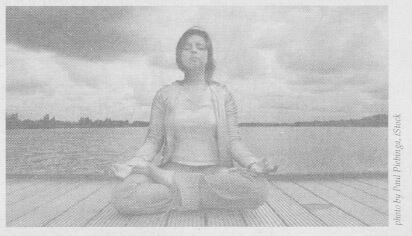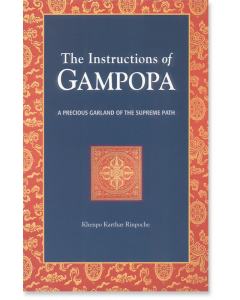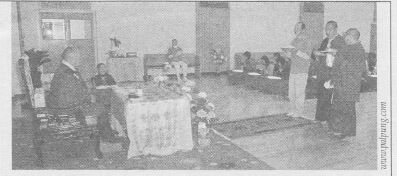| The following article is from the Summer, 2011 issue of the Snow Lion Newsletter and is for historical reference only. You can see this in context of the original newsletter here. |
How They Affect the Body
by KHENPO KARTHAR

Khenpo Karthar is widely regarded as a great master. In this adaptation, taken from his book Dharma Paths, he describes how the inner energies or winds are affected by various meditation postures.
Why do we need to sit in the various meditation positions? Is this a tradition or some cultural thing? What are the internal benefits, if any, of these positions?
The physical body is basically a combination of elements. When we suffer physical pain and sickness, it is caused by an imbalance in the elements of the body. When we talk about the elements in the present context, we are not referring so much to the flesh, blood, fluids, and so forth as to the so-called five wind energies. We say wind because there is motion, and energy because there is some activity or power that has beneficial or harmful effects. There are four peripheral or branch wind energies and one central or life wind energy. When we are able to retain these four wind energies and bring them closer to the central wind energy, we experience good health and a sense of comfort and well-being in our lives, both physically and mentally. If the four peripheral wind energies can be directed into the life wind energy, we begin to have great meditative realizations. When these wind energies are not properly balanced and retained, we are susceptible to many kinds of sickness and many kinds of distractions and conflicts. This results in chaos and confusion.
The seven positions of the body are important because they help retain the wind energies. Simply assuming these positions correctly, without focusing the mind on any particular object of concentration, brings about an air of tranquility, an air of harmony and openness. Three of the positions of the body contribute to retaining the so-called all-pervasive wind energy. These are: bringing the gaze of the eyes down in front of us, sitting in the vajra posture or the sattva posture, and putting the hands over the knees. This wind energy pervades the whole body and corresponds to the water element. For example, the ability of the body to produce heat and the functioning of the circulation are due to the all-pervasive wind energy.
The position of closing and tightening the anal sphincter and pulling our abdominal organs upward contributes to retaining the so-called downward-moving wind energy. Retaining this wind energy contributes to the taming of the mind and to developing tranquility and openness. The downward-moving wind energy corresponds to the earth element. Its activity is, for example, responsible for causing us to have bowel movements.
The position of correcting the slouching of the lower part of the back and raising the back to a straighter position contributes to retaining and properly balancing the so-called wind energy of metabolism. Retaining this wind energy contributes to the tranquility of the mind as well as to physical health and well being. The wind energy of metabolism corresponds to the element fire, and its activity affects, for example, the digestion of food.
Finally, the two positions of placing the tongue against the palate and pulling the chin back to align the neck contribute to retaining the so-called upward- moving wind energy. This wind energy corresponds to the element air, and retaining it also contributes to the tranquility of the mind.

The more we are able to I retain the four branch wind energies and direct them into the central wind energy, the greater is the tranquility of the mind and the greater is our realization and insight.
These are the four branch wind energies. When they are properly retained and directed, it is possible to have physical health and well-being as well as mental harmony, tranquility, and openness. The development of different stages of meditative advancement and realization is related to the central wind energy. The more we are able to retain the four branch wind energies and direct them into the central wind energy, the greater is the tranquility of the mind and the greater is our realization and insight. The central wind energy corresponds to the element space. The present instructions are for shamata or calm-abiding meditation. This is basic sitting practice for developing tranquility and openness of the mind, without which true insight is not possible.
When is true insight attained? The experience of vipasyana or panoramic awareness takes place when the four peripheral wind energies enter the life wind energy.
In the life stories of great yogis and meditators, it is often said that the older a certain meditator became, the more youthful she or he looked. When we hear such things, they do not make much sense in our ordinary way of understanding things, but they describe how people have worked with the wind energies and what state they have achieved in this way. As far as time is concerned, they are getting older, but because they are retaining and balancing the wind energies, their appearance is more youthful, more glowing, and more healthy.
When a great meditation master or yogi passes away, for three or four days afterwards, he or she remains in the meditation posture. This is quite well known among Tibetan Buddhists, especially in the Kagyu lineage. The person's regular respiration has stopped, there is no movement of the body and no pulse, so the person is dead. Yet the body is still in the meditation posture, and even after three or four days, it does not smell or start to decay. The person looks more alive and glowing than ever. Being around the body would not make us feel uncomfortable, because it does not have the look of a corpse. Because the yogi practiced meditation based on the seven positions, he or she has been able to direct the peripheral wind energies into the life wind energy.





